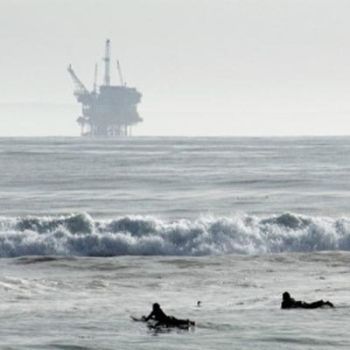
Publisher:
Bonnie King
CONTACT:
Newsroom@Salem-news.com
Advertising:
Adsales@Salem-news.com

~Truth~
~Justice~
~Peace~
TJP
Jan-14-2014 12:47

 TweetFollow @OregonNews
TweetFollow @OregonNews
New EPA Rule Requires Chemical Disclosure for Offshore Fracking
Nick Cunningham for Salem-News.comThe latest EPA rule would merely require companies to report the chemicals that they are discharging into the ocean.
 earthfirstjournal.org |
(LONDON OilPrices.com) - The U.S. Environmental Protection Agency published a rule on January 9, 2014 requiring oil and gas companies using hydraulic fracturing off the coast of California to disclose the chemicals they discharge into the ocean. Oil and gas companies have been fracking offshore California for perhaps as long as two decades, but they largely flew under the radar until recently.
An Associated Press story in August 2013 revealed that oil and gas companies had engaged in hydraulic fracturing at least a dozen times in the Santa Barbara Channel – the site of the nation’s first offshore drilling site as well as the first major oil spill. The 1969 well blowout in the Santa Barbara Channel became the impetus for a series of environmental laws such as the National Environmental Policy Act and the Clean Water Act.
Documents published through a Freedom of Information Act request showed that federal regulators have allowed drillers to dump chemicals into the ocean without an environmental impact statement assessing the effects of doing so. This was largely unknown to California regulators and the general public. The Bureau of Safety and Environmental Enforcement – the federal regulator responsible for regulating offshore oil drilling – has issued “categorical exclusions” for fracking offshore California, essentially giving frack jobs a pass on environmental assessments. The logic is that offshore fracking has largely occurred in existing wells, locations for which companies already jumped through all the environmental hoops long ago.
Offshore fracking could be much more widespread than even federal regulators are aware. According to the Environmental Defense Center, BSEE only began to learn about the extent to which fracking was occurring offshore when pressed to respond to FOIA requests.
The industry maintains that hydraulic fracturing is safe, and BSEE officials point to the fact that fracking offshore requires only a fraction of the water needed to do the job onshore.
But offshore fracking differs from the onshore practice in at least one important way. After an onshore well is fracked, the waste water is often re-injected into the ground for storage. However, offshore drillers often simply dump the waste water into the ocean – although the industry claims the water is treated before entering the marine environment.
The latest EPA rule would merely require companies to report the chemicals that they are discharging into the ocean. The rule is a weak one because relies upon companies to self-report their activities.
EPA’s announcement is a new wrinkle in the story of fracking in California, which has been much more raucously debated onshore. Last year, the state passed a controversial law that introduced the first regulations on fracking. It requires companies to disclose the chemicals used in the drilling process, obtain permits, and monitor air and water quality. Environmentalists rejected the law and are calling for a full moratorium.
Governor Jerry Brown does not support a ban on fracking and insists the new law is rigorous. Despite the complex geology that could prevent California from ever living up to its oil and gas potential, the industry and many policymakers remain in favor of trying to exploit the vast oil and gas reserves in California – both on and offshore.
By Nick Cunningham of Oilprice.com
 |
 |
 |
Articles for January 13, 2014 | Articles for January 14, 2014 | Articles for January 15, 2014

Salem-News.com:



googlec507860f6901db00.html
Terms of Service | Privacy Policy
All comments and messages are approved by people and self promotional links or unacceptable comments are denied.
[Return to Top]
©2025 Salem-News.com. All opinions expressed in this article are those of the author and do not necessarily reflect those of Salem-News.com.